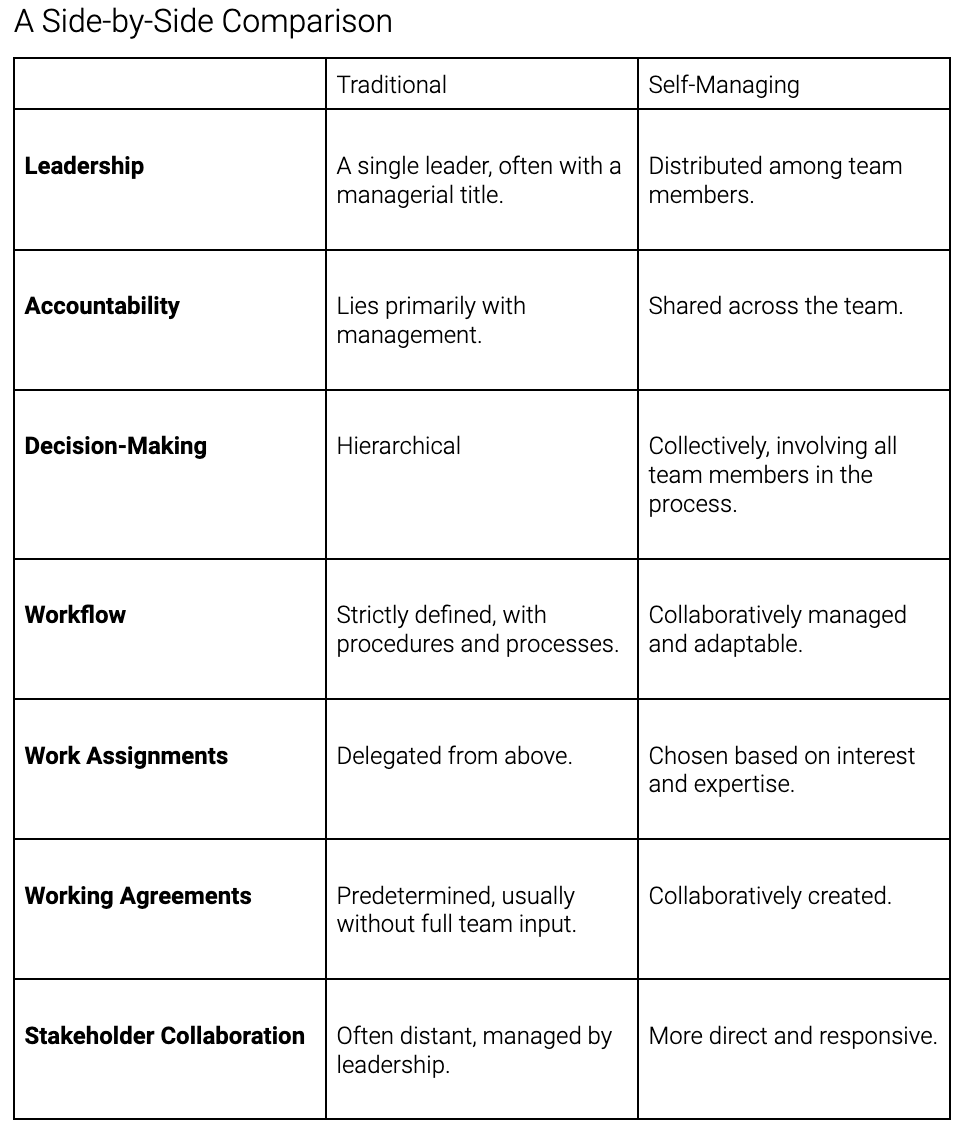Learn about purchasing for teams

We're in the midst of a profound transformation, unlike anything we've seen before as we undergo a shift from the familiar comfort of traditional team structures to the vibrant and innovative world of self-managing teams. This is where scrum comes into the picture.
Scrum isn't just a framework; it's a catalyst for this transformation. It gives teams the tools and principles they need to be self-reliant, innovative, and adaptive. The beauty of scrum lies in its simplicity and its effectiveness in empowering teams to manage themselves.
But what exactly are the differences between these two approaches, and why does it matter? This exciting exploration dives into the heart of team dynamics, comparing traditional and self-managing teams, their decision-making processes, advantages, disadvantages, and what this means for the future of collaboration.
Related reading: How Agile Teams Overcome Obstacles Created By Distance
Traditional Teams: A Comprehensive Look
Well-established hierarchies and clearly defined roles mark traditional teams. A single leader usually oversees the entire team, and work assignments flow from top to bottom. One benefit is that this structure offers stability and clarity, and there's no ambiguity about responsibilities.
However, the disadvantages of this approach can include a need for more agility and creativity. The top-down delegation of tasks may stifle innovation, and team members might feel limited by their defined roles. The predetermined working agreements can sometimes result in a disconnect between what management expects and what the team members feel is best. Moreover, stakeholder collaboration may need to be improved when mediated by layers of management, leading to misunderstandings and misaligned goals.
In traditional teams, decision-making is often hierarchical. Decisions are usually made at the management or leadership level and then communicated to the team members. This top-down approach can ensure consistency and alignment with organizational goals but may lead to a lack of empowerment and engagement at the individual level.
The advantages of this approach include clear accountability and quick decisions, especially in large or complex organizations. However, this method may limit input from team members closer to the day-to-day work, potentially overlooking valuable insights and expertise. It might also lead to resistance or lack of ownership, as decisions are often made without the direct participation of those who must implement them.
Self-Managing Teams: The Wave of the Future
Contrastingly, self-managing scrum teams breathe new life into the workplace. Leadership is distributed among the team members, creating a collaborative atmosphere where everyone has a say. People often choose their work assignments, aligning tasks with skills and interests. The flexibility in workflow allows the team to adapt quickly to changes, fostering innovation.
Yet, self-managing teams have challenges. Shared accountability, while empowering, might lead to ambiguous responsibility if not properly defined. Direct stakeholder collaboration, although efficient, requires team members to have good communication and negotiation skills, which might only sometimes be the case.
Self-managing teams take a more collaborative approach to decision-making. Decisions are often made collectively, involving all team members in the process. This method emphasizes consensus and shared ownership, and it can foster a sense of empowerment and alignment within the team.
The advantages of this approach include increased buy-in, more diverse perspectives, and a greater likelihood of innovative solutions. Self-management teams often create more responsive and tailored solutions by involving those directly impacted by the decisions. However, this method can be more time-consuming and requires clear communication, trust, and conflict-resolution skills.

What’s the Point of Self-Managing Teams?
Self-managing teams are about efficiency, empowerment, and innovation. They eliminate the need for constant supervision, freeing up time and resources. Instead of relying on rigid hierarchical structures, self-managing teams foster a culture where everyone has a voice and responsibility. This leads to a more responsive environment, enabling quicker decision-making and innovation. The point of self-managing teams is to harness the collective skills and insights of the team, allowing them to adapt and thrive in the rapidly changing business landscape. It's a model built on trust, accountability, and collaboration, and one that has proven its worth in many organizations around the world.
Why Self-Managing Teams Are Better
The move towards self-managing teams is driven by the empowerment of individuals, the agility to adapt to changes, the fostering of creativity, and improved collaboration with stakeholders. While traditional teams offer stability and clear hierarchies, self-managing teams prioritize flexibility, creativity, and shared responsibility. Their benefits outweigh some of the growing pains and challenges you may have to work through as a business fostering more agile ways of working.
Self-managing teams are becoming a game-changer, transforming how businesses approach their work, and encouraging every team member's unique contribution. Their inherent ability to innovate and respond quickly to changes shapes how organizations function.
The Road Ahead
The transition to self-managing teams is an exciting shift towards a more dynamic, responsive, and creative working approach. Embracing this change means recognizing the inherent potential in every team member, understanding the challenges, and creating an environment where self-managing teams can thrive.
For businesses that foster self-management among their employees, there can be numerous benefits. From teams who are better equipped to adapt as soon as they learn new information to an organizational culture that encourages innovation and creativity, many agile organizations have experienced such benefits.
Discover Agile Inspiration and Resources
If you’re interested in more takes on agility in the real world from the practitioners who are living it, please subscribe to our emails.











